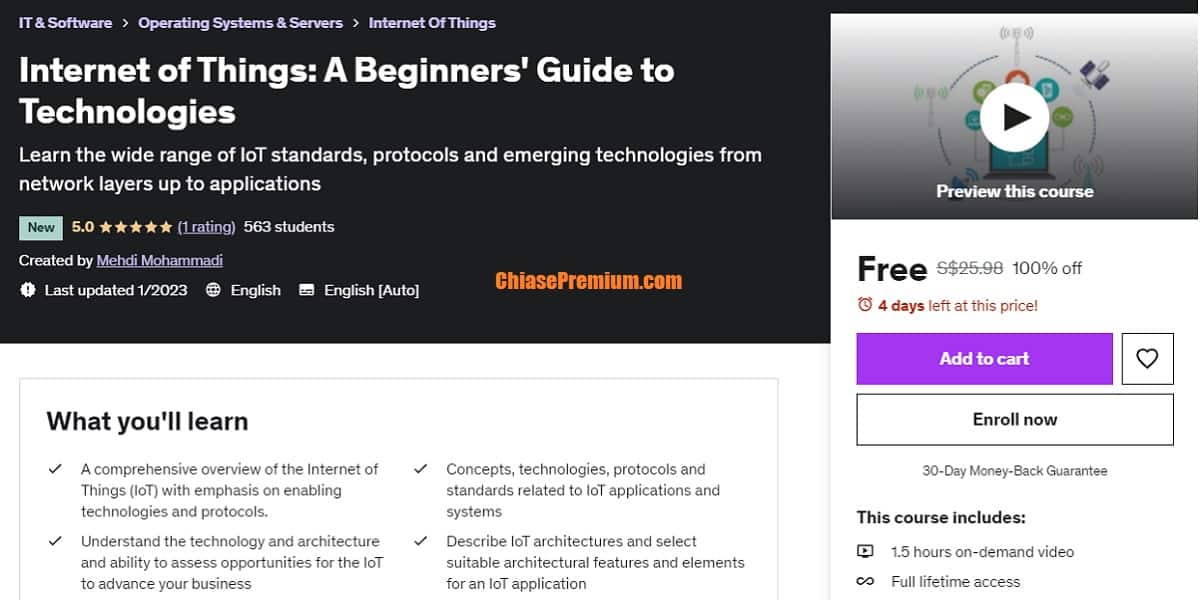Chia sẻ link đăng ký khoá học về chủ để “internet of things”.
What is Internet of Things?
The ever-expanding network of intelligent devices that are linked to the internet is referred to as the “Internet of Things.” But exactly what does that mean?
An item must be able to connect to the internet and share data in order to be included in the Internet of Things. This could be as straightforward as your fitness tracker sending information about your steps to your phone or as complex as a self-driving car sending information about traffic and road conditions to a centralized database. However, the item need not be high-tech to be a part of the Internet of Things; any physical item that has the ability to gather and exchange data is eligible.
How the IoT Works
Three main elements are necessary for the Internet of Things to function: sensors and connected devices, connectivity, and data analytics.
- Sensors and connected gadgets
These are the actual physical things that can communicate via some type of internal network or the internet. These interconnected devices gather information about themselves or their environment and transmit it back to a central database.
- Connectivity
This is how IoT devices can communicate with one another, a hub, or the internet in order to send data. Usually, WiFi or Bluetooth connections are used for this.
Data analytics is the process of storing and analyzing all of the gathered data. In order to interpret all of the gathered data and transform it into useful information, data analytics software is used. For instance, data analytics could tell you which machines are producing an excessive amount of defective widgets if you are a manufacturer. Or, if you’re a city planner, data analytics could let you know which streets are jam-packed when.
The advantages of using devices for IoT home automation Numerous advantages, such as increased automation, better insight, and increased efficiency, are provided by the Internet of Things.
Consider that your business manufactures widgets, using the examples from the previous paragraphs. You could connect your machines to the internet using the Internet of Things so that they can communicate with one another and share information about their output. This would enable you to recognize when a machine is experiencing problems so that you can fix it before it completely stops functioning.
As was previously mentioned, assume you work for the city planning department. To improve the efficiency of your roads, you could gather data about traffic patterns using IoT-connected devices.
The following are five of the Internet of Things’ most significant advantages:
improved productivity and efficiency
enhanced client services
lower costs
improved security and safety
gather information to aid in decision-making
Khóa học IoT (internet of things)
Dưới đây mình chia sẻ link đăng ký tổng hợp các khoá học về chủ đề thú vị này. Link đăng ký thường chỉ cho 200 đăng ký đầu tiên và là đăng ký truy cập vĩnh viễn.
Internet of Things: A Beginners’ Guide to Technologies
Learn the wide range of IoT standards, protocols and emerging technologies from network layers up to applications. Source: udemy.com

What you’ll learn
- “A comprehensive overview of the Internet of Things (IoT) with emphasis on enabling technologies and protocols.
- Concepts, technologies, protocols and standards related to IoT applications and systems
- Understand the technology and architecture and ability to assess opportunities for the IoT to advance your business
- Describe IoT architectures and select suitable architectural features and elements for an IoT application
- Describe, analyze and select a networking solution for an IoT application
Requirements - Basic understanding of IT systems.
- No programming experience is needed.” source: udemy.com
Description
“The Internet of Things (IoT) is a type of technology that connects smart devices and objects together, allowing them to communicate with each other. There are many different technologies and standards that make up the IoT. This course will provide you with a deeper understanding of the technologies, protocols, and standards that enable IoT. You will learn about the fundamental technologies that are currently being used in IoT, the technical details behind them, and how they can be used to create working systems. The goal of this course is to help you gain a thorough understanding of the technologies and standards that are driving the growth of IoT.
In this course we learn:
- The concepts and fundamentals of the internet of things.
- How different technologies shape an IoT system (including communication technologies, application technologies, service discovery, etc.)
- By this course you gain the knowledge to be on top of your IoT project and choose the right technology for your own IoT application.” source: udemy.com
Note: This course is only theoretical and does not cover any programming.
“This course is prepared by Mehdi Mohammadi, Ph.D., co-author of the popular IEEE tutorial paper on the IoT titled “Internet of things: A survey on enabling technologies, protocols and applications”.
No matter what your status is -like student, engineer, developer, manager, etc.- this course is designed to get you familiar with the latest technologies in the field of IoT.
Who this course is for:
- This course is designed for anyone interested in IoT area. IoT developers and engineers,
- Business analysts, programmers, students, and researchers.
- Anyone considering a career in the Internet of Things” source: udemy.com
Link đăng ký miễn phí vĩnh viễn (150 enrolls today): https://www.udemy.com/course/internet-of-things-a-beginners-guide-to-technologies/?couponCode=IOT-JAN23
Internet and Web Development Fundamentals
Learn how the Internet Works and Setup a Testing & Production Web Server. Source: udemy.com

“What you’ll learn
- How the Internet Works
- Internet Protocols (HTTP, HTTPS, SMTP)
- The Web Development Process
- Planning a Web Application
- Types of Web Hosting (Shared, Dedicated, VPS, Cloud)
- Domain Name Registration and Administration
- Nameserver Configuration
- Deploying a Testing Server using WAMP & MAMP
- Deploying a Production Server on Linode, Digital Ocean, or AWS
- Executing Server Commands through a Command Console
- Server Configuration on Ubuntu
- Remote Desktop Connection and VNC
- SSH Server Authentication
- FTP Client Installation
- FTP Uploading” source: udemy.com
This course is part-one of the nine-part series that starts by taking an in-depth look at how the internet facilitates the movement of data packets across both LANs (Local Area Network) and WANs (Wide Area Network). Students learn how to interpret various protocols such as TCP/IP, HTTP, HTTPs, SMTP and FTP. We examine the entire flow and life-cycle of data-packet movement from origin to destination. The course examines the role of DNS and SMTP servers in routing internet traffic and email transmissions. Mechanism to safeguard the movement of data, such as network routers, ports and firewalls, are also explored.
Students are then introduced to the web development process and planning stages of building websites and complex web applications. We conduct an overview of web hosting infrastructures such as shared, VPS, Dedicated and Cloud hosting solutions through case analysis. We then take a look at the role of Domain name registrars and ICANN (The Internet Corporation for Assigned Names and Numbers). Students learn to register and administer domain names through the GoDaddy domain management console. Management features such as Name Server assignment, auto-renewal, domain privacy, and domain forwarding will be covered.
With first-hand insights into the creation of effective web infrastructures and domain management, students learn to configure local testing servers. This includes installing and configuring WAMP/MAMP (Windows/MAC, Apache, MySQL, PhpMyAdmin) on a PC or MAC system. We discuss the role of each essential service as it applies to testing dynamic, database-driven web applications on a local computing system.
Students then explore the configuration of a live production server using popular cloud hosting providers such as Linode. This includes deployment and administration of Ubuntu on Linux based distributions and essential web services (LAMP Stack – Linux, Apache, MySQL, PhpMyAdmin) on scalable virtual machines. Several remote access tools such as PuTTy and Terminal will be used to administer virtual servers through the use of command lines. Servers will be configured with security in mind, using multi-user accounts, SSH authentication, and file permission management.
Students also learn to install and connect to their virtual machines using remote desktop connection tools such as Tight VNC and Real VNC. The entire Linode management console will be explored to demonstrate how to complete various tasks including: creating backups, server re-sizing, changing root passwords, DNS management, and general administration.
Lastly, the course takes a look at FTP clients and establishing connections from local machines to production servers to upload web content. We will explore the FileZilla interface and provide demonstrations on uploading, deleting and modifying remote server files.” source: udemy.com
Link đăng ký miễn phí vĩnh viễn dành cho 120 đăng ký đầu tiên trong hôm nay (free for 120 enrolls today), cập nhật 28/3/2023: https://www.udemy.com/course/internet-and-web-development-fundamentals/?couponCode=YOUACCEL73875







